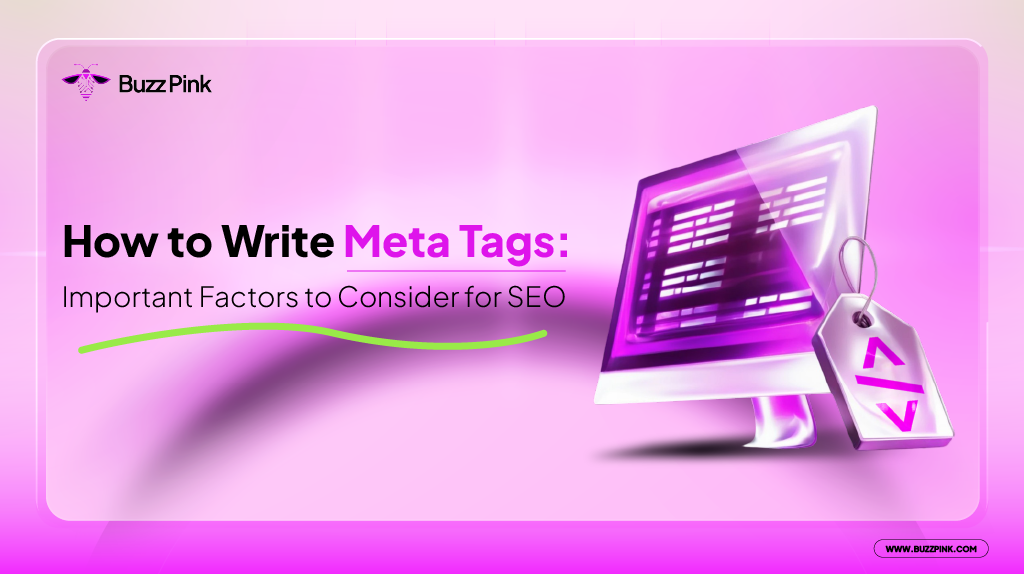Imagine using a search engine to find specific information, and the brief description below the title saves you a lot of time from endless searching. That is what we refer to as meta tags. It gives you a sneak peek at what is about to be served.
Meta tags, also known as descriptions, provide a preview of what is contained within a page, particularly a blog post. Similar to reading a journal, it is recommended that you read the abstract first to ensure that the journal covers what you are looking for. And, like an abstract, just because it’s brief does not mean it’s simple. We’ll show you how to write meta tags in the steps below.
What Are Meta Tags?
 As previously stated, meta tags are HTML elements that provide brief descriptions explaining information from a web page. Their range is considered short, at approximately 155 characters, and they are used within HTML code. Meta tags can be found on each article that appears in the search engine. They serve as a summary that search engines read to understand the content and relevance of your page before ranking it in results.
As previously stated, meta tags are HTML elements that provide brief descriptions explaining information from a web page. Their range is considered short, at approximately 155 characters, and they are used within HTML code. Meta tags can be found on each article that appears in the search engine. They serve as a summary that search engines read to understand the content and relevance of your page before ranking it in results.
Read More: What Is Programmatic Advertising and Why It Matters in Digital Marketing
Meta tags are important because they are the first indicator that visitors will click further and possibly linger on the website. As a result, you must optimize your meta tags to be as visually appealing as possible. Even if they are short, this section is critical because it determines visitor engagement. An effective meta tag can increase your click-through rate (CTR), giving your page more visibility and improving SEO performance over time.
The Purpose of Meta Tags
The goal of using meta tags is to entice visitors to click on your page’s link from the search results. Although meta tags do not directly affect your Google ranking, they can help you get more clicks. The more clicks you get, the more likely Google will consider your site relevant, resulting in a higher rank. In this way, meta tags act as a bridge between your content and potential readers, encouraging them to choose your page over others.
Even if Google does not always display the meta tags you created, including them is still essential. If Google intends to include the tags, you’ve already organized your marketing plan to lure visitors. This preparation ensures that your message stays consistent and attractive whenever your snippet is shown, helping maintain a strong first impression.
How to Write Meta Tags
 The ideal meta tags should have a limited number of characters, be concise, and be interesting. Some factors must be considered when writing meta tags to ensure that they are effective and help your SEO performance.
The ideal meta tags should have a limited number of characters, be concise, and be interesting. Some factors must be considered when writing meta tags to ensure that they are effective and help your SEO performance.
These factors include using relevant keywords naturally, writing in a tone that matches your content, and making sure the description reflects what the user will actually find on the page. A good meta tag should spark curiosity or clearly answer a user’s intent, leading to more meaningful clicks. It is also critical to avoid duplication, as each page should have a unique meta tag that corresponds to its specific content.
Maximum Characters
Google will limit your description if it is overly extended. The ideal length is between 120 and 155 characters, so you should be creative in forming the tags to ensure that the message is delivered correctly within this length. However, you should avoid meta tags that are too short because they are less likely to provide useful information. Finding the right balance in length helps your tag stand out while still delivering meaningful value to the reader.
Even though you have no control over what Google displays, writing long enough meta tags remains the best strategy. The key is to make sure it’s enough, not too long or too short. Keep it straightforward, transparent, and informative. A well-structured tag increases the chances that Google will display it as-is, improving your page’s visibility and appeal in search results.
Active Phrases
It is recommended to use an active and persuasive tone so that visitors feel compelled to click. Consider your meta tags to be an invitation that will pique the interest of those who read them. Avoid passive voice and instead be specific about what visitors will receive when they click on your page. Using action-oriented language creates a sense of urgency and relevance, making your snippet more engaging in crowded search results.
Phrases such as “learn more,” “grab it now,” and “try for free” can entice visitors to click. If you’re promoting an article, you can describe the main topics contained within it so that visitors can determine whether or not the article has the solution to their problem. This strategy will increase the likelihood of visitors clicking on your page. Tailoring these phrases to match the searcher’s intent can significantly boost click-through rates and overall user interest.
Use Keywords
As previously stated, you are not only stuffing the main topics of the article but also making sure to include the right keywords relevant to your page. If the keywords entered by visitors match those in your meta tags, Google will highlight them in bold font, making your page stand out. Synonymous keywords can sometimes be effective. To improve your chances, do a bit of keyword research beforehand so you can align your tags with actual search terms users are typing.
This method helps visitors looking for solutions feel more confident that your page is the one they’re looking for. So, never forget to incorporate the keywords naturally because it benefits not only them but also you. Proper keyword placement shows both users and search engines that your content is relevant, valuable, and aligned with their search intent.
Specify the Information
If you sell products, you can specify the meta tags by including the price, brand, size, and what the product offers. It’s useful for visitors who know exactly what they’re looking for and are prepared to buy. They can feel an instant spark with your products by using these brief tags, eliminating the need to look for other products. Adding precise details also helps filter out unqualified traffic, ensuring that your page attracts visitors who are more likely to convert.
However, you must ensure that the specified information is truly relevant to the products you are selling on your page so that visitors do not feel baited and scammed. You can improve the appearance of rich snippets when they appear in Google search results. When done right, this not only builds trust but also makes your listing visually richer, increasing its appeal compared to generic results.
Ensure Relevancy
Following the explanation, it’s important to note that you shouldn’t deceive visitors by stuffing keywords on your page that aren’t relevant to what you offer. For example, in the meta tags, you state that you are providing tips, but when visitors click, you are simply promoting your brand. This mismatch between expectation and reality can damage your reputation and reduce user satisfaction over time.
Instead of attracting customers, this strategy will drive them away. Furthermore, it will increase your website’s bounce rate while decreasing its trust score. Google may even penalize your website for manipulating its descriptions. Having said that, it is critical that you ensure the relevance of your meta tags and website. Creating honest and relevant meta tags helps establish long-term credibility, which is more valuable than short-term traffic spikes.
Unique Descriptions
Avoid using the same phrases across multiple pages. Even if your page titles differ, if the meta tags are the same, Google will classify them as uninteresting. In fact, it’s better not to write meta tags at all than to copy and paste the same thing repeatedly. Repetitive tags can confuse search engines and dilute the unique value of each individual page.
Unique meta tags will provide a positive visitor experience while also demonstrating the brand’s solid professionalism. So, take some time to write meta tags for each page, particularly those you want to appear on the first page. Tailoring each description allows you to highlight specific strengths of that page and speak more directly to your target audience.
Meta Tags for Multiple Pages
 If you have multiple pages and haven’t had time to write each meta tag, there are a few solutions to help you keep them effective. The first solution is to identify the most important page, such as a best-selling product page. Prioritizing meta tags for the most sold-out products increases the likelihood of landing on the first page, as people have already visited and lingered on the page to purchase the products. As a result, it increases your site’s trust score and, eventually, its ranking.
If you have multiple pages and haven’t had time to write each meta tag, there are a few solutions to help you keep them effective. The first solution is to identify the most important page, such as a best-selling product page. Prioritizing meta tags for the most sold-out products increases the likelihood of landing on the first page, as people have already visited and lingered on the page to purchase the products. As a result, it increases your site’s trust score and, eventually, its ranking.
Read More: What Is Prompt Engineering? A Beginner’s Guide to Mastering AI Communication
The second solution is to use WordPress’s Bulk Editor feature. This allows you to edit tags for multiple pages at once without having to open each draft individually. However, you must still pay attention to the lengths and keywords contained within the meta tags.
The Usage of Snippets
There have been some debates about the use of snippets. As previously stated, the use of snippets can improve the appearance of your site because Google displays a portion of your article, usually the first paragraph, to visitors rather than meta tags. You can’t choose which snippets to display, but you can help Google choose the correct snippets by properly arranging the phrase, so Google will eventually select the sentence.
To some people, snippets can be useful because they provide transparency into what is actually written on the page or article. However, some people argue that snippets are contaminating meta tags. Because you have no control over what appears, Google will display either the meta tags you wrote or a snippet chosen at random based on your article. Snippets can sometimes appear to be too broad rather than specific in terms of what you enter into the meta tags, making them appear less relevant.
- No Snippets
If you don’t want Google to show any snippets for a specific page, add the nosnippet meta tag to its HTML code in the advanced settings. This instructs Google not to display any descriptions of that page in search results.
Using the nosnippet tag is especially useful for content that is sensitive, legally protected, or requires full context to avoid misinterpretation. For example, financial disclaimers or gated content might not make sense when only a part of it appears in search results. It also gives you more control over how your content is represented online, which is important for brands that want to avoid misinformation or misquotes appearing in previews.
- Length of Snippets
You can also specify the maximum length of the snippet you want Google to display. You can accomplish this by using the max-snippet:[number] tag, for example, max-snippet:150 to set the limit to 150 characters. This ensures that the displayed text snippet is relevant to your page’s main message.
By controlling snippet length, you can guide how users perceive your page before clicking. A short, focused snippet can boost click-through rates because it builds curiosity or highlights the core benefit. On the other hand, if left uncontrolled, Google might pull in text that feels irrelevant or out of context, leading to confusion or reduced trust from users scanning search results quickly.
- Hidden Part of Snippets
Sometimes you don’t want to show certain parts of the page in the snippet, such as sensitive data or information that should only be seen in context. To accomplish this, add the data-nosnippet attribute to specific parts of the HTML. That way, those sections will not be visible in the snippet.
This is useful for things like pricing that may fluctuate, personalized recommendations, or internal-only notes that might be coded into the page. With data-nosnippet, you prevent those elements from being surfaced in public search results, keeping your page clean and focused while preserving user privacy or strategic messaging. It enables you to manually adjust the ratio between transparency and censorship in what your site reveals to the external audience.
Conclusion
Meta tags may be brief, but they play a powerful role in attracting clicks and guiding users to the right content. Learning how to write meta tags effectively by using clear language, relevant keywords, and unique descriptions can improve visibility and build trust with your audience. Small adjustments like active phrasing and ensuring relevancy can significantly boost your page’s performance in search results.
Snippets also influence how your page is shown on Google, and while you can’t control everything, tools like nosnippet, max-snippet, and data-nosnippet help you manage what appears. By mastering how to write meta tags and combining them with smart snippet strategies, you create a better user experience and increase your chances of ranking higher.
Kamila Putri is a content strategist and digital marketing expert who helps brands craft messages that resonate and drive results. With a strong foundation in SEO, brand voice, and data-driven strategy, she has produced content that performs, whether it's optimized web copy, lead-generating campaigns, or conversion-focused messaging. At Buzz Pink, she applies this expertise to help clients grow through smart, search-focused digital strategies that engage, inform, and convert.


